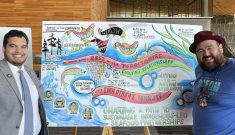Although Salford Farm Machinery and Seed Hawk Inc. are a thousand miles apart, the stories behind these two short-line companies have shared a lot of plot lines in the last decade, including success. Both companies are built on innovation, both are based in rural Canada, both have international ownership and both are aggressively growing their market share.
Interestingly, both Salford and Seed Hawk also saw opportunity when farmers started adopting reduced tillage, and they threw themselves into it wholesale. In 1992, Seed Hawk started manufacturing and selling zero-tillage seeding systems from a farm in Saskatchewan and by this spring will have sold more than 1,500 units.
Read Also

A new spin on farm legacy
What does farm legacy look like for the next generation.
Also in the early 90s, Salford introduced a vertical-tillage unit as a way to deal with heavy trash without conventional plowing and discing.
Both companies were started in small towns and continue to have plants in isolated rural areas. Salford manufactures primary tillage, secondary tillage, seeding and fertilizing equipment and attachments in southwestern Ontario in its namesake village which is really just a crossroads with a scattering of 30 or maybe 40 houses.
“Even though we operate our business from the same facility (now expanded) and location, Salford Farm Machinery has grown into a global company with markets worldwide,” says Mikhail Rodionov, company president.
Listening to farmer feedback has been integral in both Salford and Seed Hawk’s success and is a core component of their
business culture. Except now more of their customers will be calling long-distance, and some will need a translator.
International influence
In the last five years, international investment kicked both these companies into high gear. Seed Hawk’s gross sales have grown threefold since 2006. Salford’s gross sales increased 10 times in five years.
In 2006, Vderstad-Verken AB of Sweden came to North America looking for large-scale seeding equipment to get them into large-acre markets like Ukraine, Russia and Australia. They found what they were looking for in Langbank, Sask.
“We weren’t looking for a foreign investor,” says Gordon Wyatt, Seed Hawk’s general manager. “Vaderstad came to us with a business offer that benefited both parties.”
Vderstad-Verken bought 49 per cent of Seed Hawk and acquired a no-till seeding system. Seed Hawk in return got instant access to Europe. Vaderstad already had shipping channels, storefronts, service availability and marketing in Europe.
“Having this existing dealer network saved us years,” says Wyatt. “Vaderstad looks after the overseas sales of Seed Hawk systems, allowing us to focus on product development and the North American market.”
In 2004, Nuspark, a group of mechanical engineers and investors, acquired 100 per cent of Salford Farm Machinery. The new owners were already connected to farm equipment dealers in Russia.
“Our group was interested in Salford because we could easily bring the line to Russia and develop that market,” says president of Salford Machinery, Mikhail Rodionov. Originally from Siberia, Rodionov immigrated to Canada in 1998 and joined Nuspark.
The first year Salford starting shipping overseas, they doubled sales. The next year, sales doubled again. By 2007, sales to Russia and Kazakhstan had climbed so much that Salford built a distribution and assembly plant to keep up with demand.
Within a few years of Nuspark buying Salford, gross sales in Russia blossomed up to $17 million a year, about 30 per cent of their business.
Demand by Russian farmers spurred Salford to develop a no-till drill. “Today, we have hundreds of Salford air seeders in Russia,” says Rodionov. At the peak of Russian demand, Salford shipped 300 to 400 units in a year.
Surviving the meltdown
When the economic recession struck, it hit Eastern Europe and Russia terribly, stalling growth and creating credit chaos. The Russian government applied trade tariffs and local financing restrictions to buoy domestic manufacturing. Imported farm equipment sales shrivelled. Last year Salford’s sales to Russia shrunk to 10 per cent of their gross sales.
Rodionov is convinced the market will come back quickly and that Salford is in an excellent position to supply it. He says some large equipment companies are starting to build plants in Eastern Europe. “I strongly believe that it (Russian) sales will come back… if not this year, then likely in two years.”
In the meantime, Salford is expanding into Eastern Europe, including Bulgaria and Hungary, and the company has started to break into Australia and New Zealand. Meanwhile, North Dakota and South Dakota have become their largest market and the company is increasing its focus on Western Canada too.
Seed Hawk also got hit with the Russian meltdown. Two years ago Australia and former Soviet Bloc countries accounted for over $6 million of their gross sales, but that number dropped substantially last year. Australia has remained strong throughout both years.
“We’re adjusting our planning cycle accordingly, by staying focused on the domestic, European and U. S. markets,” says Wyatt.
The company adopted an idea that Vaderstad uses in Australia — using a demonstration Seed Hawk that’s towed behind a half-ton truck to seed a comparison strip right next to the farmer’s existing equipment. “We then let the results speak for themselves,” says Wyatt. “More importantly, we have to continue to listen to our farmer customers.”
Capital influx
Salford and Seed Hawk’s change in ownership and subsequent increase in gross sales spurred many changes back in Canada. The companies expanded plants, invested in research and development, and hired regional representatives and sales staff to introduce their brand to more North American farmers.
The investment gave them the teeth they needed in the marketplace. “After this deal, farmers knew Seed Hawk was here to stay,” says Wyatt.
Similarly, Salford established itself as a leader in the new vertical-tillage tool market, which gave it a launching pad for other products. “The RTS is currently our best-selling product,” says Rodionov. “However, the air seeding is increasing and I believe in two to three years will oversell the RTS.”
Currently, most of Salford’s Canadian sales are in Ontario, where RTS units are used to deal with tough corn residues. However, it sells four times more in the U. S. than north of border.
The biggest demand is for the RTS units in the North Dakota’s Red River Valley. “The RTS units are sometimes the
Demand by Russian farmers spurred Salford to develop a no-till drill. “Today, we have hundreds of Salford air seeders in Russia,” says Rodionov. At the peak of Russian demand, Salford shipped 300 to 400 units in a year.
Surviving the meltdown
When the economic recession struck, it hit Eastern Europe and Russia terribly, stalling growth and creating credit chaos. The Russian government applied trade tariffs and local financing restrictions to buoy domestic manufacturing. Imported farm equipment sales shrivelled. Last year Salford’s sales to Russia shrunk to 10 per cent of their gross sales.
Rodionov is convinced the market will come back quickly and that Salford is in an excellent position to supply it. He says some large equipment companies are starting to build plants in Eastern Europe. “I strongly believe that it (Russian) sales will come back… if not this year, then likely in two years.”
In the meantime, Salford is expanding into Eastern Europe, including Bulgaria and Hungary, and the company has started to break into Australia and New Zealand. Meanwhile, North Dakota and South Dakota have become their largest market and the company is increasing its focus on Western Canada too.
Seed Hawk also got hit with the Russian meltdown. Two years ago Australia and former Soviet Bloc countries accounted for over $6 million of their gross sales, but that number dropped substantially last year. Australia has remained strong throughout both years.
“We’re adjusting our planning cycle accordingly, by staying focused on the domestic, European and U. S. markets,” says Wyatt.
The company adopted an idea that Vaderstad uses in Australia — using a demonstration Seed Hawk that’s towed behind a half-ton truck to seed a comparison strip right next to the farmer’s existing equipment. “We then let the results speak for themselves,” says Wyatt. “More importantly, we have to continue to listen to our farmer customers.”
Capital influx
Salford and Seed Hawk’s change in ownership and subsequent increase in gross sales spurred many changes back in Canada. The companies expanded plants, invested in research and development, and hired regional representatives and sales staff to introduce their brand to more North American farmers.
The investment gave them the teeth they needed in the marketplace. “After this deal, farmers knew Seed Hawk was here to stay,” says Wyatt.
Similarly, Salford established itself as a leader in the new vertical-tillage tool market, which gave it a launching pad for other products. “The RTS is currently our best-selling product,” says Rodionov. “However, the air seeding is increasing and I believe in two to three years will oversell the RTS.”
Currently, most of Salford’s Canadian sales are in Ontario, where RTS units are used to deal with tough corn residues. However, it sells four times more in the U. S. than north of border.
The biggest demand is for the RTS units in the North Dakota’s Red River Valley. “The RTS units are sometimes the
only pieces of equipment you could get on the fields in certain soil (clay soils, wet spring) conditions,” says Rodionov.
The success of the RTS was essential in Salford establishing a reputation for being innovative. However, that brand recognition is sometimes a mixed blessing. In Ontario it’s difficult to break through the misconception that it’s a micro-company, specializing only in vertical tillage.
Salfords units often have high resale value, fuelling a “Honda” or “John Deere” approach to pricing. Buyers are willing to pay more for Salford equipment upfront if they know they’re going to get more at trade-in. “Quality is one of our primary goals and our niche,” says Rodionov.
Seed Hawk’s niche is seeding equipment for the minimum-tillage small-grains market. With gross annual sales of over $25 million, Seed Hawk invests 10 to 15 per cent in research and marketing.
The bulk of Seed Hawk’s sales are domestic, accounting for over 90 per cent of volume. Wyatt expects the company to continue focusing on domestic sales, with some expansion into the dryland farming areas in the U. S. “Seed Hawk is focused on increasing penetration of the small grains seeding equipment market in North America,” he says.
The no-till seeder market in the Canadian Prairies today is worth $300 to $500 million. About 70 per cent of that market is dominated by three originally Canadian
only pieces of equipment you could get on the fields in certain soil (clay soils, wet spring) conditions,” says Rodionov.
The success of the RTS was essential in Salford establishing a reputation for being innovative. However, that brand recognition is sometimes a mixed blessing. In Ontario it’s difficult to break through the misconception that it’s a micro-company, specializing only in vertical tillage.
Salfords units often have high resale value, fuelling a “Honda” or “John Deere” approach to pricing. Buyers are willing to pay more for Salford equipment upfront if they know they’re going to get more at trade-in. “Quality is one of our primary goals and our niche,” says Rodionov.
Seed Hawk’s niche is seeding equipment for the minimum-tillage small-grains market. With gross annual sales of over $25 million, Seed Hawk invests 10 to 15 per cent in research and marketing.
The bulk of Seed Hawk’s sales are domestic, accounting for over 90 per cent of volume. Wyatt expects the company to continue focusing on domestic sales, with some expansion into the dryland farming areas in the U. S. “Seed Hawk is focused on increasing penetration of the small grains seeding equipment market in North America,” he says.
The no-till seeder market in the Canadian Prairies today is worth $300 to $500 million. About 70 per cent of that market is dominated by three originally Canadian
companies — Bourgault, Morris and Flexi-Coil (now owned by Case IH). “Seed Hawk and Seedmaster are the other two players and with John Deere would account for the remainder of the market,” says John Schmeiser, executive vice-president Canada West Equipment Dealers Association.
In the last year, Salford has entered that market with a double-disc air seeder. “I project that in four to five years our sales will double in North America, with the uptake of our seeding lines,” says Rodionov.
“So far, the market is very accepting in the U. S. because double-disc technology is well accepted there,” says Rodionov. Salford is demonstrating air seeders in Texas, Nebraska and Western Canada this year.
Dealership network
One of the challenges for smaller equipment companies when breaking into markets is establishing retail distribution. Seed Hawk’s Wyatt agrees. “Initially it was tough sledding,” he says.
However, by meeting with dealer principals, both individually and in groups, they’ve been able to negotiate workable solutions. Now Seed Hawk has 14 dealers representing 29 locations in Western Canada and the United States.
Another difficulty for smaller companies is setting up credit and financing platforms. The major equipment companies own their own leasing divisions. After the economic melt down, many
companies — Bourgault, Morris and Flexi-Coil (now owned by Case IH). “Seed Hawk and Seedmaster are the other two players and with John Deere would account for the remainder of the market,” says John Schmeiser, executive vice-president Canada West Equipment Dealers Association.
In the last year, Salford has entered that market with a double-disc air seeder. “I project that in four to five years our sales will double in North America, with the uptake of our seeding lines,” says Rodionov.
“So far, the market is very accepting in the U. S. because double-disc technology is well accepted there,” says Rodionov. Salford is demonstrating air seeders in Texas, Nebraska and Western Canada this year.
Dealership network
One of the challenges for smaller equipment companies when breaking into markets is establishing retail distribution. Seed Hawk’s Wyatt agrees. “Initially it was tough sledding,” he says.
However, by meeting with dealer principals, both individually and in groups, they’ve been able to negotiate workable solutions. Now Seed Hawk has 14 dealers representing 29 locations in Western Canada and the United States.
Another difficulty for smaller companies is setting up credit and financing platforms. The major equipment companies own their own leasing divisions. After the economic melt down, many














